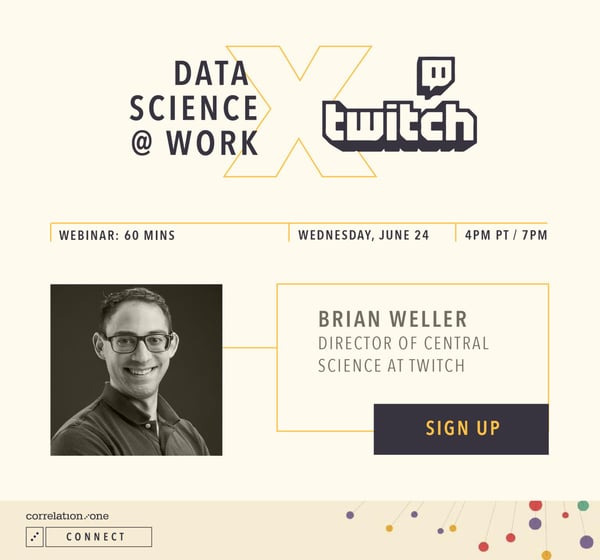Data Science @ Work: Twitch
Over 200 data scientists, data analysts, and data engineers from around the world joined Data Science @ Work: Twitch on June 24.

Brian Weller, Director of the Central Sciences team at Twitch led a discussion with 4 members of the team who discussed the role of science at Twitch, different roles across Twitch's data teams, and how Twitch evaluates applicants during the candidate selection process.
"Data informs almost everything that we do at Twitch. When it come to matching viewers with content they will love, ensuring safety in anonymous or pseudonymous spaces, identifying user needs from both the creator and viewer sides, making sure people have a great time together and are able to enjoy entertainment- the Science of Data is essential to building a growing, thriving community at Twitch."
Prior to opening the floor to questions from the audience, the Twitch team shared background on their roles, day-to-day job responsibilities and activities, and unpacked the role of 'science' in Twitch's mission to build the future of live entertainment.
Throughout the session, panelists fielded live questions from viewers including:
- How different is the job responsibility between a data analyst and data scientist at Twitch?
- What differences should you be prepared for when switching between academia and industry?
- If you don't have professional data science experience, what kinds of projects should you embark on in your own time to stand out during the recruitment process?
- Are there any specific educational backgrounds or education levels (Masters/ Phds) that you look at while hiring for entry level data science roles?
- How important is it to develop storytelling and communication skills for a data scientist?
Following the broader panel discussion and Q&A, Brian and Sanjay Kairam-Senior Research Scientist, Community Health walked through a simulated interview highlighting how great candidates tell their story during the recruitment process and some tips for preparing for what's next in the Twitch candidate experience.
We invite you to watch the full video of Twitch�۪s talk above. ��If you would like to join a future Data Science @ Work session, feel free to follow C1 on Linkedin or join one of our Data Science for All communities on Meetup.
If you are interested in opportunities at Twitch, please apply to C1 Connect here.
About Data Science @ Work
There is a transparency problem in the data talent market.
At Correlation One we work with thousands of data scientists, data analysts, and data engineers from around the world, and we often hear from job candidates that they are unsure how to evaluate different data career paths, do not know what skills they should focus on developing, and need some guidance on how to find their next data science job.
Across industries, companies are challenged to define the difference between a great data scientist, data analyst, and data engineer on job descriptions. This makes it difficult for candidates to understand what their day-to-day responsibilities will be, how certain jobs will impact their career trajectories, and how common job titles like 'data scientist' differ from one company to another.
This lack of transparency leads to a huge waste of time for both candidates and companies. Candidates adopt 'spray and pray' job application strategies, applying to hundreds of roles that have 'data' in their title. Talent teams are then forced to search through thousands of resumes to find great candidates who then must be triaged to the appropriate role search. Oftentimes, the interview process uncovers that though a candidate is an excellent data scientist, her goals and skills do not align with the role. This wastes the time of the applicant and Senior Data Scientists responsible for conducting late stage technical interviews.
We launched the C1 Connect Data Science @ Work webinar series to break down the communication barriers between hirers and the world's best data scientists, data analysts, and data engineers. Each week, our C1 Connect community is invited to hear directly from data leaders who share background on their career journeys, what working in their industry means practically for data professionals, and some tips for navigating the job search (and if applicable, how they can pursue opportunities with their teams).
After each session, candidates are invited to raise their hand for feature opportunities on C1 Connect by sharing their C1 Connect Datafolios - brief profiles designed to communicate the skills, roles, aspirations, and project work specifically for data professionals. Using C1 Connect's Talent Match Algorithm, we pass on qualified candidates who fit the profile for active opportunities to the proper next steps in the candidate selection process.





